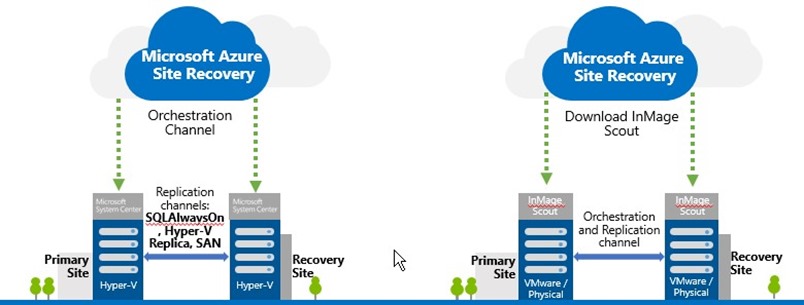Protecting SAP Solutions with Azure Site Recovery
We have released a new whitepaper detailing how to build a DR solution for SAP systems based on Azure Site Recovery Services. Building a Disaster Recovery Solution for SAP Based on Microsoft Azure is a step-by-step procedure that allows customers with a basic level of knowledge on Azure Site Recovery to implement an end-to-end DR solution for SAP.
1. What is Azure Site Recovery Services & how is it used to Protect SAP Systems?
Azure Site Recovery (ASR) Services is a comprehensive Disaster Recovery suite that orchestrates Disaster Recovery (DR) failover and failback of on-premise resources. ASR can orchestrate Enterprise-2-Enterprise (E2E) scenarios and Enterprise-2-Cloud (E2C) scenarios. The focus of the Whitepaper is E2C. Azure Site Recovery uses a platform independent Replication Channel. Currently there are two Replication Channels:
- Hyper-V Replica – Supported for E2E and E2C
- InMage Scout – Supported for E2E. E2C will be released in the future
The whitepaper we have released deals with SAP on Hyper-V deployments. Another whitepaper will be released once the InMage Scout E2C Replication Channel is in preview. The ASR Replication Channels allow Virtual Machines to be asynchronously replicated to Azure every 30 seconds, 5 minutes or 15 minutes.
2. What are the Advantages of Azure Site Recovery?
Azure Site Recovery offers organizations substantial business value:
- Azure Regions are comprised of multiple data centers. The resiliency and redundancy built into Azure Datacentersfar exceeds what most customers and hosters are able to provide
- Azure Site Recovery substantially lowers the cost of DR solutions. Virtual Machines are not charged for unless there is an actual DR event (such as fire, flood, power loss or test failover). No Azure compute cost is charged for VMs that are synchronizing to Azure. Only the storage cost is charged
- Azure Site Recovery allows customers to perform non-disruptive DR Tests. ASR Test Failovers copy all the ASR resources to a test region and start up all the protected infrastructure in a private test network. This eliminates any issues with duplicate Windows computernames. Another important capability is the fact that Test Failovers do not stop or disrupt VM replication from on-premise to Azure. A test failover takes a “snapshot” of all the VMs and other objects at a particular point in time
- ASR “Recovery Plans” allow customers to create sequenced DR failover / failback procedures or runbooks. For example a customer might create a ASR Recovery Plan that first starts up Active Directory servers (to provide authentication and DNS services), then execute a PowerShell script to perform a recovery on DB servers, then start up SAP Central Services and finally start SAP application servers. This allows “Push Button” DR
3. What about VMWare and Physical Servers?
Microsoft will provide full DR capabilities for customers running VMWare and Physical Servers soon when InMage Scout is released for E2C scenarios. Another whitepaper will be produced that will document the setup and configuration of ASR at that time
4. Where can I get more Information on Azure Site Recovery Services?
Before deploying Azure Site Recovery services for SAP systems we recommend to setup a small test environment and become familiar with ASR concepts, configuration and technologies. Large complex SAP landscapes require careful analysis and forethought before deploying ASR. Therefore it is recommended to deploy a Windows 2012 R2 Hyper-V server, sign up for a free Azure Trial Account and test replicating small non-SAP VMs to Azure. The links below provide the software and information required to do this.
After becoming familiar at a basic level with Azure Site Recovery please read the whitepaper Building a Disaster Recovery Solution for SAP Based on Microsoft Azure. This whitepaper adds SAP specific content to the ASR solution. the paper can be found here:
https://msdn.microsoft.com/library/dn745892.aspx
5. Can I get a Free Trial Account for Azure & Azure Site Recovery Services?
A free trial account for Azure is available here. The account is valid for 1 month.
6. Links
SAP Notes:
- 1928533 - SAP Applications on Azure: Supported Products and Azure VM types
- 1999351 - Troubleshooting Enhanced Azure Monitoring for SAP
- 1380654 - SAP support in public cloud environments
- 2015553 - SAP on Microsoft Azure: Support prerequisites
- 2039619 - SAP Applications on Microsoft Azure using the Oracle Database: Supported Products and Versions
- 1329848 - Oracle Support for Microsoft Hyper-V
Azure Site Recovery Blogs
- https://azure.microsoft.com/blog/2014/10/02/disaster-recovery-to-azure-using-azure-site-recovery-is-now-ga/
- https://azure.microsoft.com/en-us/services/site-recovery/(Sign up for Free Trial)
- https://blogs.technet.com/b/scvmm/archive/2014/10/30/monitoring-azure-site-recovery.aspx
- https://azure.microsoft.com/en-us/documentation/services/site-recovery/
Win2012 R2 Hyper-V + SQL Server 2014 Free Trial Software
- https://www.microsoft.com/en-us/evalcenter/evaluate-windows-server-2012-r2
- https://www.microsoft.com/en-us/evalcenter/evaluate-sql-server-2014
How to setup AlwaysOn between on-premise and Azure
- https://weblogs.asp.net/scottgu/azure-new-documentdb-nosql-service-new-search-service-new-sql-alwayson-vm-template-and-more (go to section Virtual Machines: Support for SQL Server AlwaysOn, VM Depot images)
- https://blogs.msdn.com/b/sqlcat/archive/2014/09/22/extending-alwayson-availability-group-to-remote-azure-datacenter-powershell.aspx
AlwaysOn Availability Groups Now Support Internal Listenerson Azure Virtual Machines (recommended to use internal load balancer for SAP AlwaysOn installations instead of external load balancer)
How to setup AlwaysOn between Azure Regions
Test Latency between on-premise and Azure Regions – WARNING: For accurate test results run this on a server on a wired connection somewhere close to the core switch. Results on laptops on wireless connections are not accurate
New Larger VMsand using SSD for SQL Bufferpool
